Do-it-yourself brick gazebo: drawings, diagrams, step-by-step instructions
Spring and summer are a period of active recreation outside the city.A gazebo will be useful for spending time outside and cooking barbecue. Here you can hide on a rainy day, enjoy the fresh air, and cook a delicious lunch or dinner over an open fire. A brick gazebo is a functional addition to the arrangement of a summer cottage.
The content of the article:
Advantages and disadvantages of brick gazebos
Wood, bricks and metal are commonly used as construction materials. A brick gazebo is a priority for builders and summer residents, since it is the easiest to build.
INYou should choose building brick because the following advantages are in favor:
- Durability and terms of use. Brick allows you to create durable walls that can withstand the effects of precipitation, temperature changes, and the influence of open fire during cooking.
- Minimum effort required to maintain the building. There is no need to cover the walls with a protective film or paint, which saves time and money for the summer resident. It is enough to carry out 1 general cleaning per year, cleaning the bricks.
- Cool. Due to the low heat transfer rate of the walls, the air inside the closed gazebo warms up less, and coolness is maintained during the heat and stuffiness in the open areas of the dacha.
- Capitalism. A brick structure can have strong walls, and if you add window blocks, you get a building that can be heated.Moreover, this is feasible both at the construction stage and later.
- Beauty. When renovating a summer cottage, the gazebo becomes the pearl of space, adding style to the area.
In the design of the building, you can use the method of combining different materials with brick, decorate the walls with metal or wooden decor, make an unusual roof, or complement the window openings with mosaics or colored glass.
Before planning and developing a future project, experts advise studying the disadvantages of using bricks:
- Foundation. A brick structure requires a solid foundation that will prevent subsidence and tilting of the gazebo, which will lead to rapid destruction.
- Difficulties. Without preparation, at least theoretical, it will be difficult to build a gazebo out of brick. Requires accuracy and precision, knowledge of proper laying and dilution of the connecting solution. Construction business workers recommend not to take risks and turn to contractors to work with bricks.
- Space. For a brick structure, you will need to allocate a plot of land, which reduces the amount of territory for summer cottage planting.
- Pricing. Compared to a wooden or metal frame, brick will require more cash injections.
Studying the material, getting acquainted with its advantages and disadvantages, the owner must make a choice. The disadvantage in the form of money spent on a gazebo is offset by the level of strength and duration of use of the building.
Design options for brick gazebos
Before starting construction or hiring a separate construction team, the owner needs to study the types of bricks, design solutions for interior or exterior decoration, and types of brick gazebos:
- Open.If the cottage is used for relaxation on warm days, an open gazebo will be the best option. Construction progresses faster, easier, and less material is required. Construction begins with a light foundation, on which the required number of support pillars are built from brick. At the last stage, the roof is created. It is recommended to use wood for it, which will help reduce the overall weight of the gazebo and fit it into the landscape of the site.
- Half open. An option for couples with children who want to spend a lot of time at their summer cottage, preferring not only to relax, but also to garden, care for plants, seedlings, harvest, and celebrate significant family dates. The gazebo consists not only of a foundation, supports and roof, but also of full walls. Most often, a brick monolith covers the interior space on 3 sides. Inside you can install a table, barbecue, or equip a full-fledged summer kitchen. The semi-open type of brick structure is popular among summer residents.
- Closed. For those who visit the dacha both in summer and in the cold season. The gazebo has walls, glazed window units, and a lockable door. Electricity and heating must be installed inside. The closed gazebo project includes the construction of a bathroom.
| Construction type | Period of use | Foundation | Support pillars | Walls | Roof | Window |
| Open | Summer | Easy | + | — | + | — |
| Half-open | Spring Summer | Average | + | + | + | — |
| Closed | All year round | Complete, just like for home | + | + | + | + |
For ease of understanding, you can use a comparative table created on the basis of information provided by construction companies.
Having analyzed the data displayed in the table, we can judge that if the frequency of visits to the dacha is 2 times a week in the summer, a major closed gazebo will not be required, while for families who visit their plot weekly during the year, there will be little benefit from a simple open design.
Preparatory stage
A DIY brick gazebo requires an understanding of the construction processes. Where to start and where to finish, you should decide in advance.
Choosing a place for a future gazebo
The project is being prepared for the landscape of the territory allocated for construction. The first thing to decide is where the brick structure for family recreation should be located. Builders warn about the impossibility of building on a slope or in a lowland, since water stagnation is possible in such a place. The subsequent destruction of the foundation and walls will not be long in coming.
If an open gazebo is being built, the place must be protected from strong winds (other buildings, trees, etc.). Those who are planning to install a barbecue or stove should know that all this is located away from the house.
Choosing the type of construction
Open - will allow you to enjoy nature, beautiful views of forests or fields, and inhale the pleasant smell of flowers or fruits growing on the site. At the same time, the supporting pillars made of brick buildings are not able to protect a person from slanting rain, wind or hail.
If you choose a closed gazebo, the view will be poor. It will take more effort to keep the building clean (wash windows, the brick itself, etc.).
When compared with the previous two types of structures, the semi-open style of the gazebo wins. WITHThe owner gets the opportunity to shelter from bad weather, continuing to cook meat on the grill or enjoying communication with family, and also retains more opportunity to admire the view of the site and beyond.
Preparation of materials and tools
Construction requires the use of tools and auxiliary materials:
- bayonet type shovel;
- roulette;
- twine for marking the future foundation;
- reinforcement and wire to strengthen the structure;
- concrete mortar for pouring;
- boards to create formwork;
- waterproofing material that prevents the base from getting wet and cracking;
- plumb line or level - help in achieving surface evenness;
- trowel;
- welding machine;
- container for mixing concrete or concrete mixer;
- roofing material for roof;
- timber that allows you to make strong floors;
- bricks are the main material for supporting pillars and walls.
Before starting the preparatory stage, experienced workers advise warning neighbors about noisy work with bricks.
Before erecting a building, the site must be leveled: cut off excess soil if there are elevations or make an embankment if there is a failure. Preliminary marking of the future foundation is important, after which the interfering fertile soil of the summer cottage is removed (by 20-22 cm).
Construction stage
After working through the preparatory stage, the main part of the work begins. After studying the drawings, step-by-step instructions for building a brick gazebo are being developed.
Foundation for a gazebo
There are 3 types - columnar, strip, slab. The first and second are suitable for light open construction.If the choice falls on a semi-open or closed brick building, then preference should be given to a slab foundation.
When pouring a columnar base, it all starts with placing the pillars to a depth of 50-100 cm, depending on the soil. To strengthen, concrete is poured onto pipes or welded reinforcement.
To get a strip foundation, you will need to dig a ditch 50 cm deep around the perimeter of the future foundation. The area is covered with sand to a height of 20 cm. The layer should be shed with water and compacted. A ten-centimeter layer of crushed stone is placed on the sand. The frame of the future brick foundation is created from reinforcement. Builders advise using reinforcing material with a diameter of 1.2 cm for work. After erecting the formwork from boards, the base must be filled with concrete. After drying, it is removed. Waterproofing material is laid on the resulting hardened layer.
The slab type foundation is performed as follows:
- Within the boundaries of the selected marking, a pit is dug into which formwork from boards is installed.
- Crushed stone is poured into the lower part of the future foundation.
- The remaining space on top is filled with cement mortar.
For a swampy area, strong piles are used as a foundation for bricks.
Walling
In semi-open and closed types of gazebos, both a support pillar and a wall are used. To fasten bricks and brick rows together, a solution is used: for 1 part of cement you need to take 3 parts of fine sand. The adhesive is applied to the top and side planes. The evenness of the rows can be monitored using a plumb line and level.
After laying out the first brick row, you need to lay out a waterproofing material, to which the main height of the pillars and walls is adjusted.
To build a wall, you can use one of the existing masonry. Simple to implement is considered to be “half a brick”. It is suitable for constructing an open gazebo.
For semi-open walls, you can use the lattice masonry option, in which a gap is deliberately left between the bricks.
The type of masonry is selected based on the shape of the future structure, the intended design and internal arrangement.
Floor arrangement
According to residents of large cities, a dacha must be cozy and comfortable for living. These rules also apply to recreational areas, where not only the room, but also the floor should be neat, comfortable and beautiful. A simple, uncomplicated base can be created using one of the standard materials:
- concrete;
- paving slabs;
- porcelain stoneware;
- stone;
- tree.
Regardless of the chosen floor covering, the first step is to fill the foundation and level its upper surface.
In order to fit the gazebo into the natural landscape of the site, to give it a natural look, in particular in an open type of structure, it is recommended to use classic natural materials for the floor - stone or wood.
The use of paving slabs opens up the possibility of creating unusual individual room designs. However, difficulties may arise during the installation of the slabs and their alignment.
Concrete floors are easy to pour, versatile, and have a long service life. At the same time, builders recommend supplementing concrete with elements of another material. Porcelain tiles are good for their resistance to temperature changes, durability and convenience.
Gazebo roof installation
The type depends on the design and shape of the gazebo. But they also take into account the wishes of the owner.If the structure is quadrangular, then a suitable option is a pitched or gable roof, a hip roof.
Polygonal gazebos require the development of multi-slope roofs, for example, 6 corners, 6 slopes. This allows you to properly “cover” the space and make it easier for snow to melt in the future.
The support pillars under the base of the roof are connected at the top by strapping in the form of wooden boards 15 cm wide and 5 cm thick on average. For strength, metal corners are screwed in as fasteners. The rigidity of the upper part is maintained by bridges. On top of the rafters, construction workers install sheathing that is covered with waterproofing material. The top layer is laid roofing material:
- profiled sheet;
- metal tiles;
- ondulin.
The color range of the roof helps make the gazebo the accent of the site or, on the contrary, organically fits it into the surrounding landscape.
Barbecue stoves in gazebos
A stove or barbecue is a feature of a country holiday. The equipment can be stationary, built into the floor or wall, or portable, which makes cooking easier, making summer residents more free to move.
An important condition is an additional separate foundation on which the equipment will be erected. The base for the barbecue oven should be poured in parallel with the base of the gazebo itself, which allows you to simultaneously build recreation areas and culinary experiments.
A do-it-yourself gazebo is a beautiful, functional option for improving your summer cottage. A simple option for assistance in construction is instructions that help you step-by-step develop all the processes, select tools, and materials.
When thinking about erecting a building on a summer cottage, the owner will need to carefully study the positive and negative aspects of independent work and hiring builders.
A selection for you:
- DIY gazebos made of wood
- How to build a comfortable metal gazebo with your own hands
- We build a gazebo from polycarbonate with our own hands
- How to make a gazebo from a profile pipe with your own hands
- We make a gazebo from scrap materials with our own hands
- We build a modern gazebo with a barbecue for the dacha with our own hands
- How to make a beautiful gazebo from pallets
- Do-it-yourself gazebo with a pitched roof
- DIY hexagonal gazebo
- How to make a 3 by 4 gazebo with your own hands
What kind of masonry did you prefer in your gazebo when building walls and why? Bookmark the article and share the link on social networks.

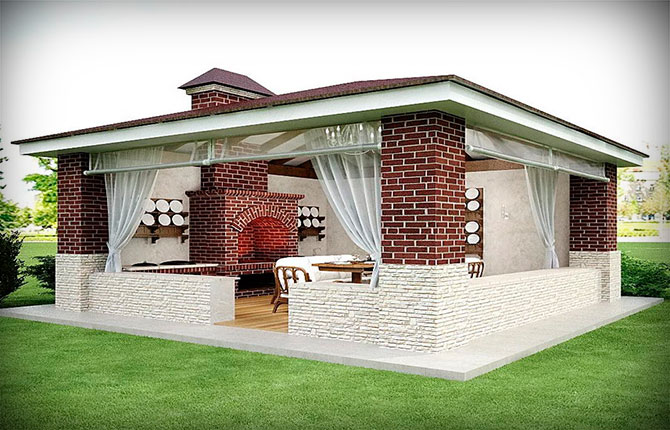
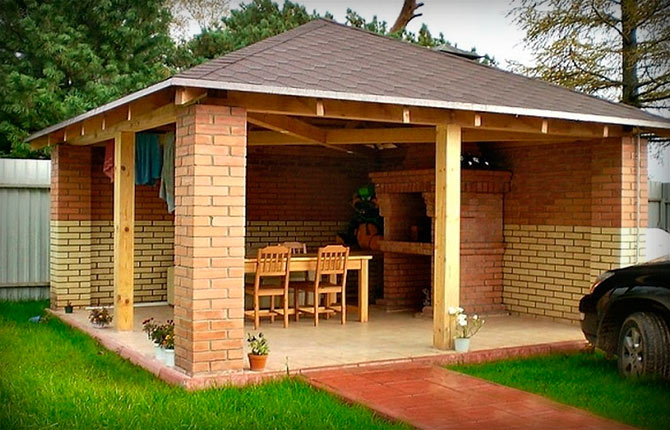
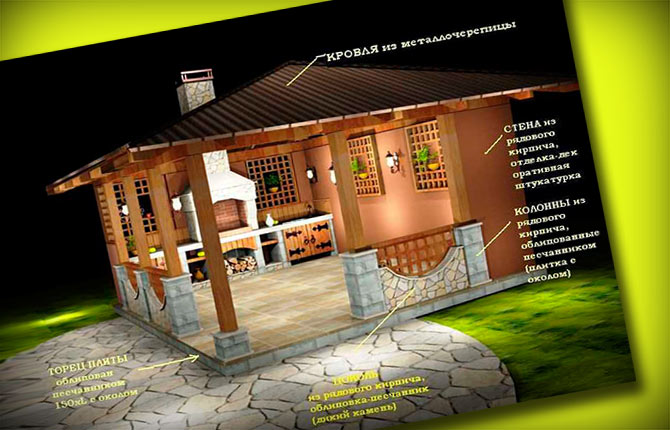
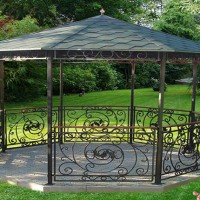
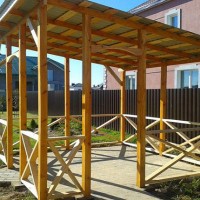

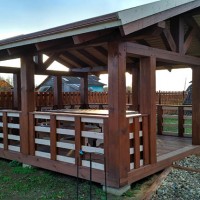






I always use half-brick masonry for such construction projects. It looks very impressive when choosing red brick.
Regular masonry works best. You just have to carefully align the seams for beauty, otherwise you’ll get messy lines.
I put all the rows in half a brick, and then in a brick with a protrusion inward, so that it becomes a kind of stand for a bench.